I completed my largest embroidery to date—the wandering ghost—in June. The stitched area is 53 x 21 cm (21 x 8.5 inches).
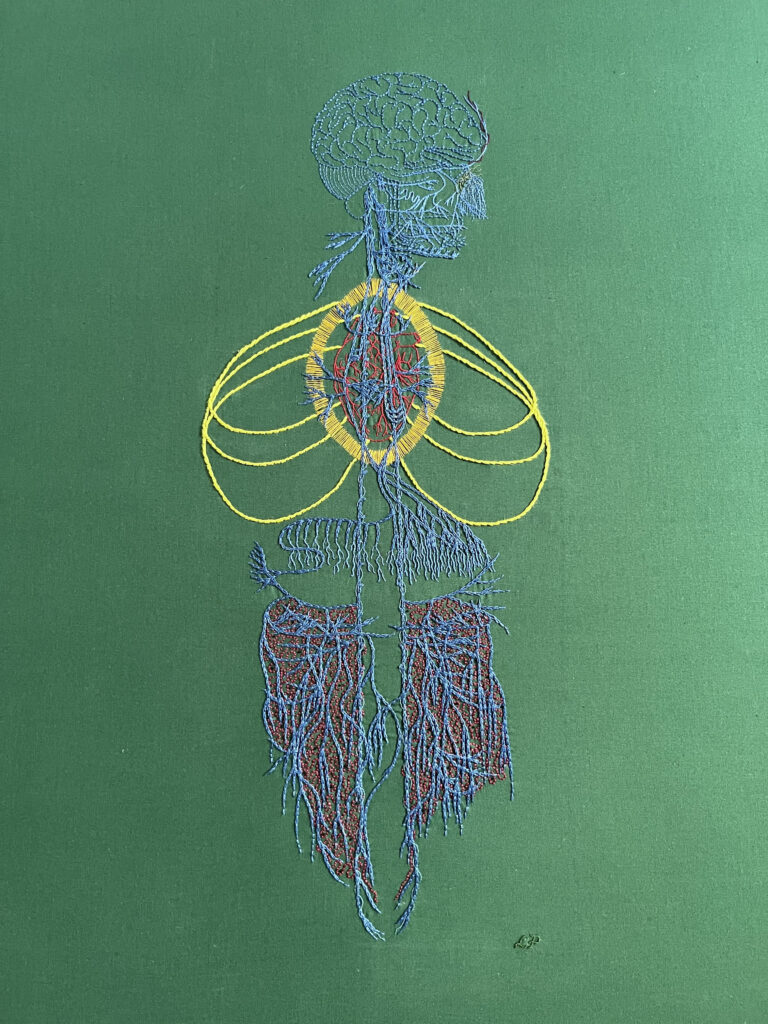
Clean up took a lot more time than usual because the chalk pencil I used was especially stubborn to wash out of the cotton and I wanted to wet block instead of iron it which took a bit of figuring out since that’s a new process for me. But it is done! Aside from cleanup I worked on it from June 14, 2023 to June 12, 2024. An entire year.
Read on for more about my process for this piece.
The inspiration for this piece was to learn more about the vagus nerve. Biomedical research has shown vagus nerve inflammation in ME/CFS, especially with orthostatic Intolerance (OI) and Postural Orthostatic Tachycardia Syndrome (POTS). Though I no longer have POTS symptoms, I definitely have OI, and I was curious if the techniques of polyvagal theory might help both my OI as well as some of my other ME/CFS symptoms. The answer is definitely yes! I am generally less lightheaded and my heart rate stabalizes much more quickly these days. I have since integrated many polyvagal theory techniques into my day since they have had such a beneficial effect for me.
Learning polyvagal theory in such an experiential way means this piece is less about my symptomatology and more about polyvagal sensations, some of them very positive. All the research I did about the vagus nerve made me realize what a delicate yet important creature it is inside us. Not only is the nerve spread throughout the body, but it affects multiple organs and systems as well as having an immunity component. If something goes awry with the vagus nerve, the effects are felt across all systems.
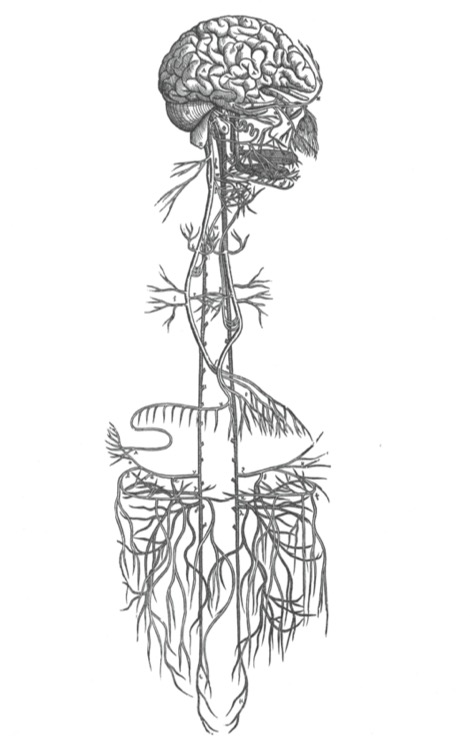
I started with an engraving of the vagus nerve from Vesalius’ Fabrica. “Vagus” is Latin for “wanderer” since the nerve traverses so much of the body. The title the wandering ghost came to me during a workshop with Liz Orton. I was working with the Vesalius image and her writing prompts made me look at it in a more poetic and less literal way. The vagus nerve is so embedded and intertwined with the rest of our anatomy, but separated out like it is in this image it really struck me how ghostlike it was. I also feel like there’s a connection between our subconscious, our memories, and the vagus nerve. Perhaps it is what holds the ghost of us. Hence, the wandering ghost.
I started learning polyvagal theory via Deb Dana’s audio course Befriending Your Nervous System: Looking Through the Lens of Polyvagal Theory, and then read her book Anchored. There was much of the same information in both, but the audio course has multiple guided exercises and I really wanted that experiential component. Late in the creation of this embroidery I read Stanley Rosenberg’s book, Accessing the Healing Power of the Vagus Nerve, which has a much more neuroscience- and physiology-based approach compared to Dana’s counselling and imagistic approach. The two approaches complement each other very nicely. Much of the sensate imagery on my embroidery came up while working with Dana’s material, and Rosenberg’s approach has made finding a ventral vagal state very quick and easy.
A Polyvagal Theory Primer with Embroidery Details
Polyvagal theory splits the vagus nerve into three sections: dorsal (in the abdominal area), sympathetic (along the spine), and ventral (the chest and face). The three parts are described from the most basic survival state—dorsal—up through the sympathetic, and into the social engagement system of ventral vagal.
The Dorsal Vagus
The dorsal vagus is spread throughout the abdomen, and a dorsal vagal state is one of heaviness, a wish to disappear, and low energy. It is activated when we encounter a life threat. Think of a turtle retreating into its shell, or a deer freezing and collapsing at the sight of a predator. Depression is also a dorsal vagal state, and when post-exertional malaise (PEM) is triggered, that also feels like a dorsal state to me.
Dorsal means “towards the back” and the dorsal vagal branch arises from the floor of the fourth ventricle of the brain, between the medulla (the brainstem) and the cerebellum (the cauliflower-like part of the brain at the back bottom of the skull).
My experience of dorsal is one of heaviness and overwhelming fatigue. In my embroidery I used a roiling burgundy pattern punctuated by black French knots in the abdominal area to evoke this heaviness and discomfort. There is also usually a weightiness just below my diaphragm so I elongated the nerves in that area to show that sensation.
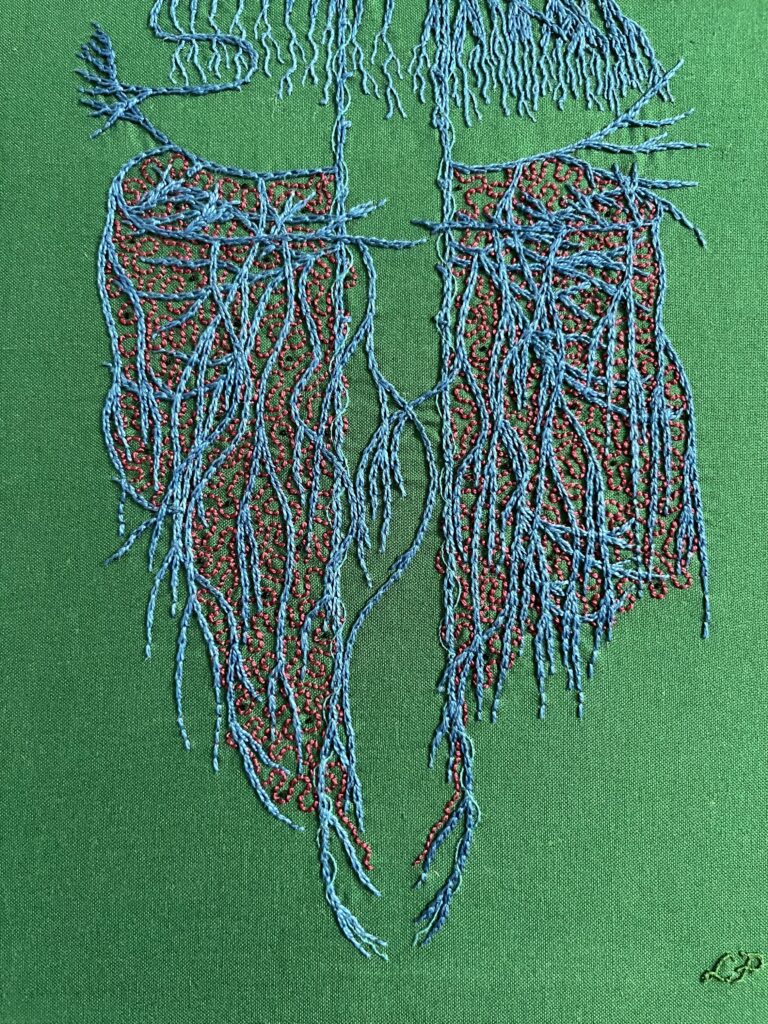
The Sympathetic System
Sympathetic activation is what we’re most familiar with as a stress state. It’s fight or flight, agitation, and anxiety. I sense sympathetic states mostly along my spine so I wrapped both the long lines of the central vagus in and electric bright blue whipped back stitch.
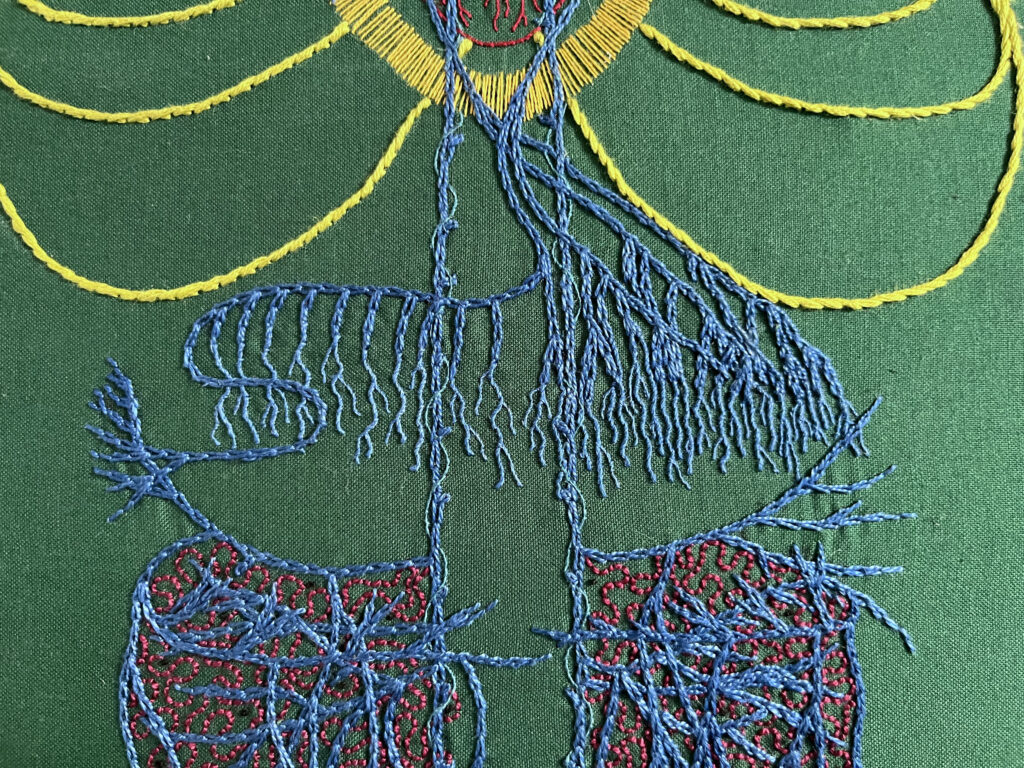
Most people are familiar with the sympathetic state, but polyvagal theory techniques teach us how to modulate our states. Resilience is not just achieving biological homeostasis, but also easily shifting from a stressed state to one of calm and clarity.
The Ventral Vagus
The ventral vagal state is one of being calm and engaged with the world around us. We feel capable of what we set out to do, ready to meet the world. It is centred in the face and chest. It’s called “ventral” because the branches of the ventral vagus are from the front of the brainstem.
For this area I added a heart to the original Vesalius image since that is where I feel warmth emanating from when I’m in a ventral state. The golden halo around the heart is that warmth, and the bright green/yellow stem stitch moving from the central vagus and around the ribs to the heart is the imagery that works for me to move from a sympathetic to a ventral state.

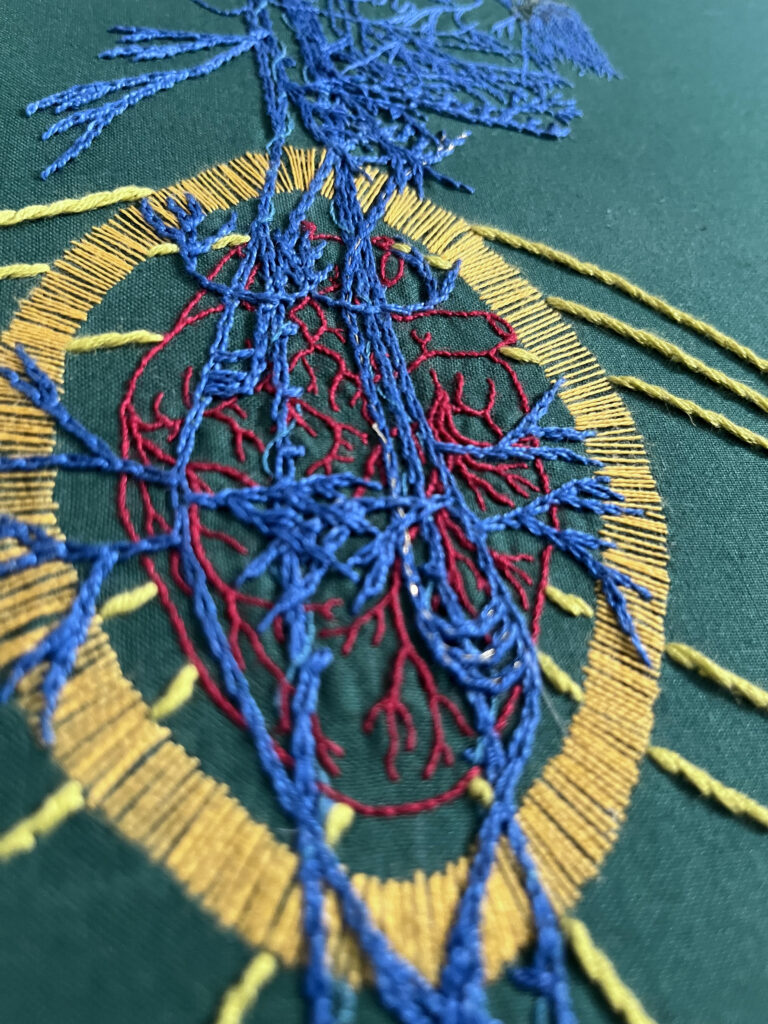
There is also a thin line of gold thread moving up the recurrent laryngeal nerve. If I can sense this nerve in particular and how it moves from the heart to the nest of nerves in the larynx, I am able to move immediately into a ventral vagal state accompanied by a deep, cleansing sigh.
The vagus nerve starts as cranial nerve X emanating from the brain stem, and connects to multiple nerves in the face, especially the eyes and tongue.
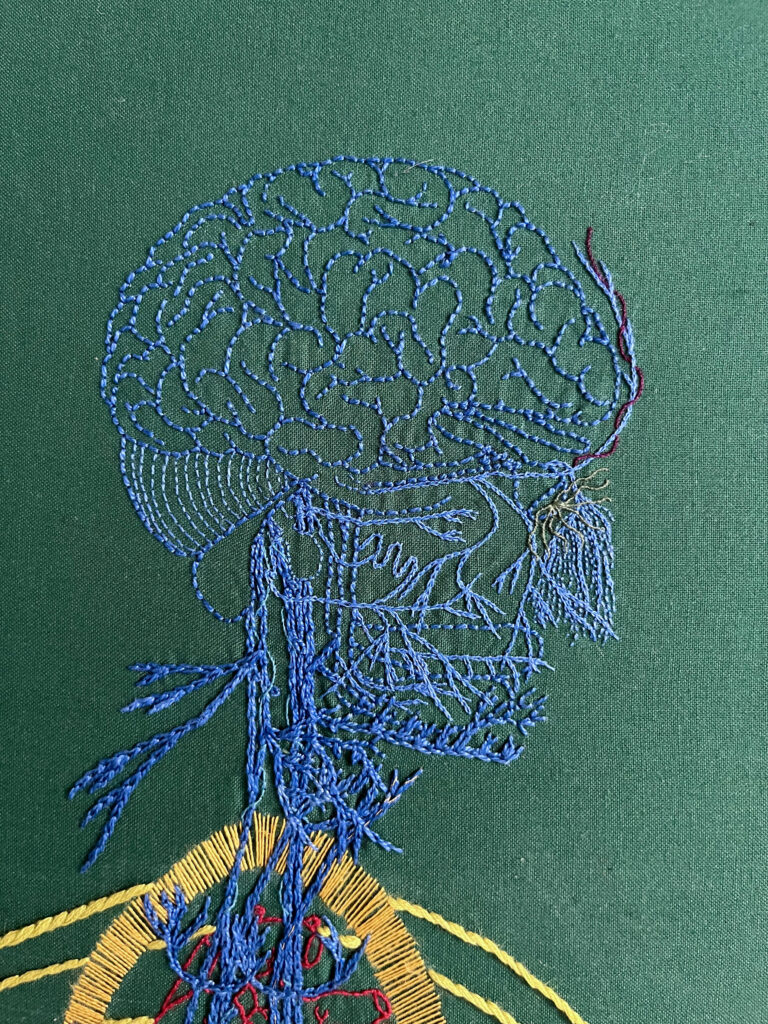
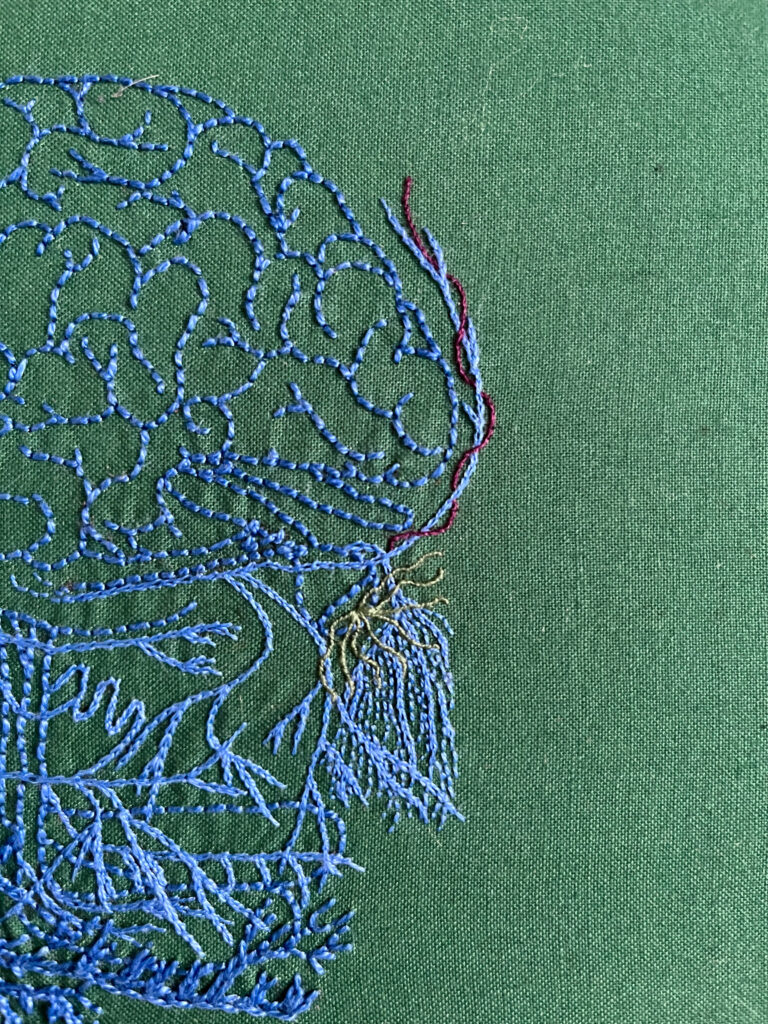
In my embroidery there are small moss green emanations from the eye to represent the softening I feel there and how that softening connects with other people when I’m in a ventral state. There is also part of the trigeminal nerve branching to the brow wrapped in dark purple. I feel a gentle opening in this “third eye” area when I am in a deep meditative state that branches upwards to the crown of my head.
Polyvagal Theory in Practice
Polyvagal theory has become such an integral part of dealing with my symptoms day to day. My interoception—the awareness of the inside of my body—and neuroception—the awareness of my nervous system—continue to improve with practice, which also means that when I go into a dorsal or sympathetic state I recognize it earlier and able to move out of it more easily and in less time. My heart rate variability (HRV) comes back to baseline much faster after an illness flare as well.
One comment I’ve heard from many people while sharing the work-in-progress for this embroidery is how frustrated they are with their vagus nerve, or even that they hate it. I know all too well how easy it is to feel frustrated with certain body parts when they create symptoms, but the vagus nerve is so intertwined with our emotional state that to have such intense negative feelings about it is counterproductive at best and will increase symptoms associated with it at worst.
Thinking of my vagus nerve as a sort of sentry—something that warns me of danger—has helped resolve most of the frustrations I’ve had with my vagal symptoms. An experience I had last winter illustrates this point well:
Shifting from a Sympathetic State
I am very scent sensitive and it takes multiple washes to remove the scented laundry products that transfer into my clothes from chairs, examination tables, and hospital sheets. I have a set of comfortable, easy to wash clothes that I wear to most of my medical appointments and when I need to go to the ER. I often end up in the ER at night, because that is when liver symptoms are most likely to develop into a fever.
I had a routine MRI booked for a Friday night. I don’t generally have any anxiety around MRIs because I’ve had so many and because I find enclosed spaces relaxing. When it was time to get ready I changed into my hospital clothes. Suddenly my anxiety started to spike. It was a very visceral sort of anxiety, but I knew, consciously, that I had no reason to be anxious.
I had a few minutes before we had to leave so I checked in with my neuroception, knowing I was in a sympathetically activated state (fight or flight). I asked what danger my vagus nerve might be sensing and then I realized: hospital clothes, at night, about to head to the same hospital I go to for my liver issues. My nervous system interpreted these three factors as a likely ER visit with fever, septicaemia, and a week of hospitalization. But I wasn’t symptomatic, I was just going for an MRI. I focused on my exhalations, on the fact that this was routine imaging, and by the time we arrived at the hospital (a 5 minute drive), I was calm and back in a ventral vagal state.
Without polyvagal theory I probably would have been anxious for the entire MRI, but tuning in to my neuroception, listening to the story my vagus nerve was telling me, and then modulating my state because that story wasn’t accurate, made me appreciate just how much the vagus nerve affects how we interact with our environment.
So, if you are frustrated with your vagus nerve, I encourage you to appreciate its job as sentry and learn how to gently make friends with it because it’s doing an important job.
Shifting from a dorsal state
Shifting from a dorsal state requires a different sort of attention. We are usually energized when in a sympathetic state but lack energy and motivation in a dorsal one. For someone without ME/CFS or OI, things like splashing cold water on their face or having a cold shower will usually reset their nervous system and pull them out of dorsal, but with ME/CFS that sort of eustress (positive stress) is often too much for us, especially if we are already in PEM.
One of the things I’ve needed to learn with ME/CFS is to respect and honour my fatigue, and polyvagal theory has helped me differentiate between physical or cognitive fatigue and the type of neurological fatigue that is a shiftable dorsal state. I can modulate out of a dorsal state caused by emotional overwhelm or a migraine through finding pleasure in things. Sensory pleasures like scents (either food or essential oils), tastes (like tea or fruit), and sounds (like my favourite ambient music) gently shift me back to ventral vagal, as does the practice of finding glimmers.
Glimmers are what Deb Dana describes as “micro-moments of regulation that foster feelings of well-being”. I call them tiny beautiful things. I have many pieces of art and collections of small objects that are glimmers in my studio. I also look out the window at plants or birds as a glimmer practice. A favourite item of clothing also works as a glimmer for me. Noticing a glimmer then taking the time to appreciate it pulls me gently from dorsal back to ventral. Even if I’m very symptomatic physically, feeling pleasure in these small ways allows me to relax and wait the symptoms out which is more restorative than fighting or getting frustrated with them. For more on glimmers Deb Dana has a page about them here: https://www.rhythmofregulation.com/glimmers
Simple Polyvagal Exercises
I am still using much of the imagery from this piece to modulate my vagus response. There are a few gentle physical exercises I do that are easy ways to modulate your own response. I invite you to experiment with the following:
a. The Fake Sigh
Sighing calms the nervous system. Think of how your body naturally sighs when you relax or when you’re exasperated and need to reset. Sighs can be voiced or unvoiced. I use unvoiced sighs because they are less taxing on my system and it is only when I’m already relaxed that a voiced sigh comes easily to me.
A sigh happens in three parts: an initial inhalation, a second, deeper inhalation, and then a long exhalation. You can recreate this by inhaling through your nose, then inhaling through your nose again, letting the breath drop down to the bottom ribs, then exhaling through an open mouth. Breathe normally after and see what effect it has had for a few breaths and then try again.
b. The Side Eye
Stanley Rosenberg calls this the “basic exercise”. Lie on your back, interlock your fingers and place them behind your head like a pillow, elbows out to the side. Close your eyes and look to one side without moving your head. Hold your eyes in this position until you sigh, yawn, or swallow—all signs that you’ve come into a ventral vagal state. At first this can take up to a minute, so wait patiently.
Once you’ve felt the response, bring your eyes back to centre and see how you feel, then repeat with your eyes looking to the other side. There may be differences in your experience from one side to the other.
This exercise is surprisingly effective. After you get comfortable with it you can do it without your hands behind your head and in any position.
c. Ears
There are many places on and around the ears that help calm the vagus. You can pull on them or massage them in any spot, but the points I find most effective are behind the ears.
Place your fingers behind your ears. A bit back of the crease where your ears meet your head is a bony ridge. Place one finger gently on this ridge and slide the skin slightly upwards and hold it there until you sigh, yawn, or swallow. Then slide the skin slightly downwards until you get the same response. Come back to centre, then slide the skin towards the back of your head until you have a vagal release. You can do one side at a time or both sides together.
I find my ears get quite tight due to my hyperacusis and this often relaxes them very quickly and helps lessen my symptoms.
~
There are many polyvagal theory exercises in Stanley Rosenberg’s book and a lot of videos online. I’ve only brushed the surface with these ones.
My Polyvagal Plans
I don’t feel like I’m done with my explorations of the vagus nerve yet. I took a lot of notes while doing Deb Dana’s audio course then went back and highlighted some of the turns of phrase and concepts I especially liked and just finished writing a poem for each of those. I probably have more than a full book of poems and will soon start editing them. I have a clear idea for a text-heavy vagus nerve embroidery so I’ll choose some of the writing for that and see what I want to do with the rest.
I also have a very clear idea for a smaller embroidery piece solely about the recurrent laryngeal nerve because it feels so very important for evoking a ventral vagal state for me. I have that piece slated for after my current iliac vein piece.
I’ve also looked into getting a vagus nerve stimulator that hooks onto the ear. I’m on the fence about it because they’re so expensive and it might drop my already low resting heart rate, but the research I’ve read on them makes me wonder if it might help my symptoms even more than the polyvagal practices I’ve been doing on my own.
This piece also felt like a slight shift away from my symptomatology work. I’m curious where that might take me in the future. Stay tuned to find out!
